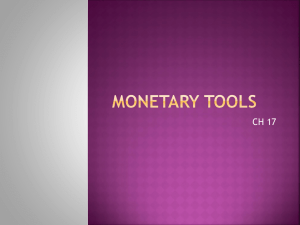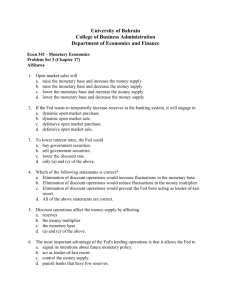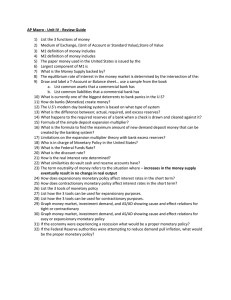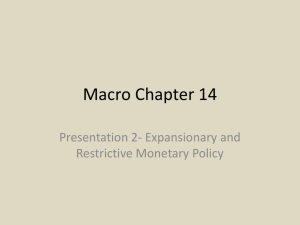Tools of Monetary Policy
advertisement
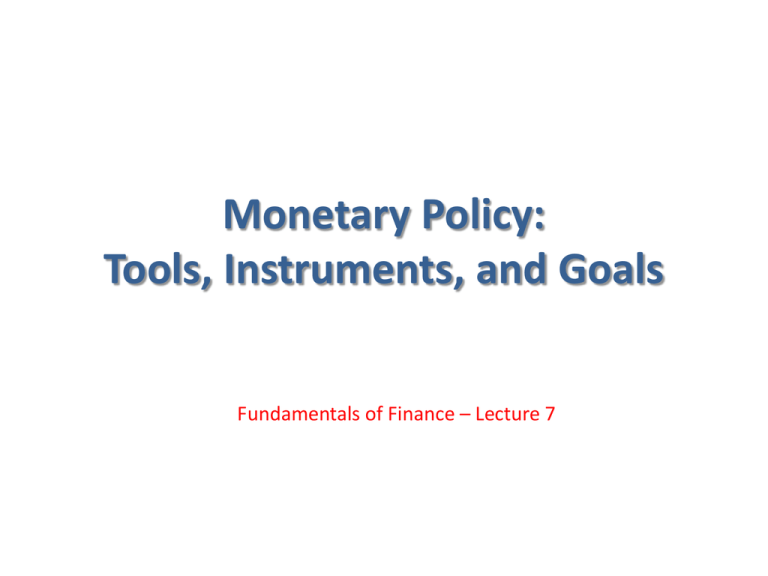
Monetary Policy: Tools, Instruments, and Goals Fundamentals of Finance – Lecture 7 Monetary Policy: TOOLS AND INSTRUMENTS Tools of Monetary Policy • Open market operations – Affect the quantity of reserves and the monetary base • Changes in borrowed reserves – Affect the monetary base • Changes in reserve requirements – Affect the money multiplier Target of Monetary Policy: Interest Rate (Federal Funds Rate, or Interbank Money Rate) - The interest rate on overnight loans of reserves from one bank to another. The Demand for Bank Reserves • Why do banks demand reserves? – The CB requires banks to hold a certain percentage of reserves as deposits; – Banks may choose to hold excess reserves to ensure against increased deposit outflows. • Every unit held in reserve is not earning interest as a loan – The interest rate represents the interest that could have been earned; – As the interest rate falls, the opportunity cost of holding reserves falls. Demand for Reserves Interest Rate iff,2 iff,1 RD R2 R1 Reserves Supply of Reserve Interest Rate iff,3 RS id iff,2 iff,1 NBR Reserves Equilibrium in the Market for Reserves An Open Market Purchase Interest Rate id RS1 RS2 iff,1 iff,2 RD NBR1 NBR2 Reserves An Open Market Sale Interest Rate id iff,2 iff,1 RS2 RS1 RD NBR2 NBR1 Reserves Lowering the Discount Rate (Non-Binding) Interest Rate Id,1 RS1 Id,2 iff,1 RS2 RD NBR1 Reserves Lowering the Discount Rate (Binding) Interest Rate RS1 id,1 iff,2 = id,2 iff,1 RS2 id,2 RD NBR1 R2 Reserves The Central Bank as a Lender of Last Resort • One of the most important functions of the CB is its role as a lender of last resort to the banking system. • Banks in need of liquidity may borrow from the CB at the discount rate. • A large increase in the demand for reserves (demand for liquidity) by banks is tempered by the CB’s ability to step in and lend at the discount rate. – The interest rate is actually capped by the discount rate. • While this role has helped avert some bank panics, it may have created moral hazard costs – Banks know they will be bailed out by the CB if they fail – Encourages them to take on high-return/high-risk loans – If the loan comes in, they keep all the profits – If the loan fails, the Fed subsidizes the losses. Raising the Reserve Requirement Interest Rate RS1 Id,1 iff,2 iff,1 RD2 RD1 NBR1 Reserves The Channel/Corridor System • Without reserve requirements, can a central bank still control interest rates? • If banks don’t hold reserves, then how can the CB induce changes in interest rates through changes in reserves? • One solution is the channel/corridor system – Banks set up one facility that stands ready to lend to banks at a guaranteed lending rate (il) – This facility will supply as many reserves to banks as they desire at this rate – Another facility is set up that accepts deposits from banks and pays them a guaranteed interest rate on these deposits (ir) – This facility will accept an unlimited amount of deposits. – These two interest rates present the lower and upper bound for the federal funds rate negotiated between banks. The Channel System Conventional Monetary Policy Tools • During normal times, the Central Bank uses three tools of monetary policy—open market operations, discount lending, and reserve requirements—to control the money supply and interest rates, and these are referred to as conventional monetary policy tools. Open Market Operations • • • • Dynamic open market operations Defensive open market operations Primary dealers Repurchase agreements Advantages of Open Market Operations • The CB has complete control over the volume – Compare this to discount lending, in which the CB sets the price of borrowing, but does not directly control how much banks actually borrow. • Flexible and precise – Can be used to enact both small and large changes in the monetary base. • Easily reversed – Mistakes can be quickly corrected in a way that would not have been possible with reserve requirements or discount lending. • Quickly implemented – There is no administrative delay to conducting open market operations. Discount Policy and the Lender of Last Resort • Discount window • Primary credit: standing lending facility – Lombard facility • Secondary credit • Seasonal credit • Lender of last resort to prevent financial panics – Creates moral hazard problem Advantages and Disadvantages of Discount Policy • Used to perform role of lender of last resort • Cannot be fully controlled by the CB; the decision maker is the bank • Discount facility is used as a backup facility to prevent the federal funds rate from rising too far above the target Monetary Policy: GOALS The Price Stability Goal and the Nominal Anchor • Over the past few decades, policy makers throughout the world have become increasingly aware of the social and economic costs of inflation and more concerned with maintaining a stable price level as a goal of economic policy. • The role of a nominal anchor: a nominal variable such as the inflation rate or the money supply, which ties down the price level to achieve price stability. Other Goals of Monetary Policy • Five other goals are continually mentioned by central bank officials when they discuss the objectives of monetary policy: – (1) high employment and output stability – (2) economic growth – (3) stability of financial markets – (4) interest-rate stability – (5) stability in foreign exchange markets Should Price Stability Be the Primary Goal of Monetary Policy? • Hierarchical Versus Dual Mandates: – hierarchical mandates put the goal of price stability first, and then say that as long as it is achieved other goals can be pursued – dual mandates are aimed to achieve two coequal objectives: price stability and maximum employment (output stability • Price Stability as the Primary, Long-Run Goal of Monetary Policy - Either type of mandate is acceptable as long as it operates to make price stability the primary goal in the long run, but not the short run Linkages Between Central Bank Tools, Policy Instruments, Intermediate Targets, and Goals of Monetary Policy Criteria for Choosing the Policy Instrument • Observability and Measurability • Controllability • Predictable effect on Goals Inflation Targeting • Public announcement of medium-term numerical target for inflation • Institutional commitment to price stability as the primary, longrun goal of monetary policy and a commitment to achieve the inflation goal • Information-inclusive approach in which many variables are used in making decisions • Increased transparency of the strategy • Increased accountability of the central bank Inflation Targeting (cont’d) • New Zealand (effective in 1990) – Inflation was brought down and remained within the target most of the time. – Growth has generally been high and unemployment has come down significantly • Canada (1991) – Inflation decreased since then, some costs in term of unemployment • United Kingdom (1992) – Inflation has been close to its target. – Growth has been strong and unemployment has been decreasing. Inflation Targeting (cont’d) • Advantages – – – – Does not rely on one variable to achieve target Easily understood Reduces potential of falling in time-inconsistency trap Stresses transparency and accountability • Disadvantages – – – – Delayed signaling Too much rigidity Potential for increased output fluctuations Low economic growth during disinflation Inflation Rates and Inflation Targets for New Zealand, Canada, and the United Kingdom, 1980–2011 Lessons for Monetary Policy Strategy from the Global Financial Crisis 1. Developments in the financial sector have a far greater impact on economic activity than was earlier realized 2. The zero-lower-bound on interest rates can be a serious problem 3. The cost of cleaning up after a financial crisis is very high 4. Price and output stability do not ensure financial stability Lessons for Monetary Policy Strategy from the Global Financial Crisis (cont’d) • Should central banks respond to bubbles? – Strong argument for not responding to bubbles driven by irrational exuberance – Bubbles are easier to identify when asset prices and credit are increasing rapidly at the same time. – Monetary policy should not be used to prick bubbles. Lessons for Monetary Policy Strategy from the Global Financial Crisis (cont’d) • How should Central banks respond to asset price bubbles? – Asset-price bubble: pronounced increase in asset prices that depart from fundamental values, which eventually burst. • Types of asset-price bubbles – Credit-driven bubbles • Subprime financial crisis – Bubbles driven solely by irrational exuberance Lessons for Monetary Policy Strategy from the Global Financial Crisis (cont’d) • Macropudential policy: regulatory policy to affect what is happening in credit markets in the aggregate. • Monetary policy: Central banks and other regulators should not have a laissez-faire attitude and let credit-driven bubbles proceed without any reaction.

